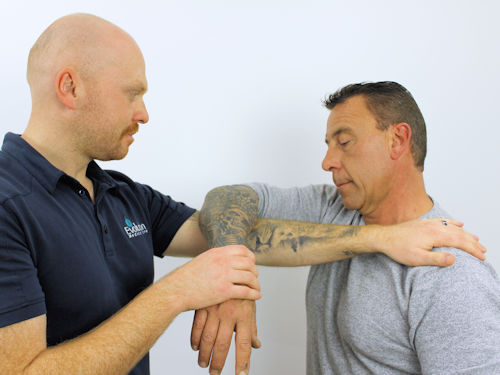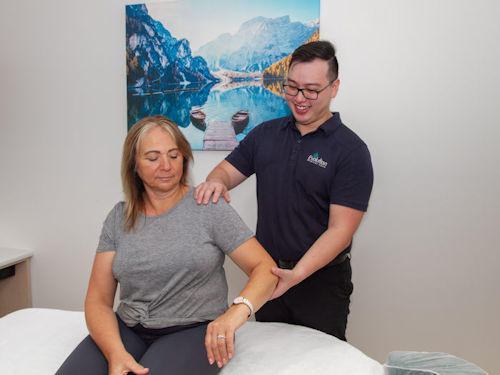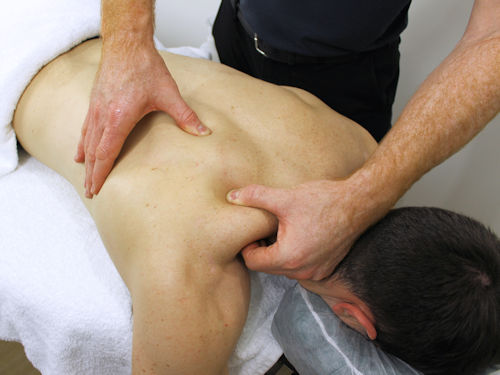The shoulder contains a complex set of muscles, tendons, and ligaments that enables the arm to perform a variety of everyday activities like brushing your teeth or putting on clothing.
Shoulder problems are very common and depending on the type of issue, may develop over a period of time or appear suddenly with or without a clear cause. Shoulder pain can affect anyone regardless of age, although those over the age of 50 have a higher chance of shoulder issues.
The shoulder is very similar to the hip as they are both ball and socket joints. The biggest difference between the two is the shape of the actual joint. The hip joint consists of a deep bony socket in the pelvis where the head of the thigh bone is inserted and secured with thick ligaments and is designed to bear weight with specific movements only.
The shoulder on the other hand is comprised of a shallow bony socket in the shoulder blade (scapula) where the head of the arm bone attaches with ligaments and is stabilised by a series of muscles called the rotator cuff. This means the shoulder allows for a wider range of movement, but it has less stability, making it a commonplace for injuries.

Causes of Shoulder Pain
Factors such as lifestyle, trauma, and even genetics play a role in shoulder problems.
Inflammation: The shoulder has various structures surrounding it that may become inflamed, which reduces the space available for the shoulder to move freely. This can cause pinched nerves, resulting in pain. Common areas of inflammation include:
- Bursitis: The bursa is a sac of fluid that is located at a few major joints including the shoulder, elbows, hips, and knees. It absorbs impact when under strain and reduces friction between tissues. The bursa may swell with repetitive use or if the area experiences trauma.
- Tendonitis: Tendons join muscles to bones. It has a limited blood supply meaning once it is damaged it is difficult to deliver nutrients from blood to the area for repair. Wear and tear due to repetitive use can cause tendons to become inflamed.
- Synovitis: Most of the joints through our bodies are encased with a synovial membrane – think of it as the WD40 of the human body. It secretes fluids which allows bones to glide smoothly next to each other. When the synovial membrane is inflamed, it may be due to other health conditions such as osteo/rheumatoid arthritis.
Trauma: When the shoulder encounters a strong force, the structures surrounding it undergo a lot of stress. This trauma has the ability to inflict severe damage on the shoulder, which in turn produces intense pain. Trauma to the shoulder can cause many issues such as:
- Bone fractures
- Joint dislocations
- Rotator cuff strain or tear
- Inflammation
Frozen Shoulder Syndrome(Adhesive Capsulitis): A condition where the joint becomes stiff causing limited range of motion and pain. The cause is unknown, but some people can develop a frozen shoulder after recovering from an injury.
Nerve impingement: Swelling or inflammation of the tissues around the neck and shoulder can compress the nerves, causing discomfort down the arm. This can be like shooting pain, pins and needles, and numbness.
Rotator Cuff Tears: The muscles that primarily support the shoulders are known as the rotator cuff which stabilises the shoulder and allows great mobility in performing everyday tasks. If any one or more of these muscles are injured, further complications may arise.
Heart Attack: Sometimes having pain in the shoulder may be a warning sign that something worse is coming. If there is shoulder pain accompanied with difficulty breathing and tightness in the chest, call Emergency Services – 000.
Current treatments for Shoulder Pain
Not all shoulder problems may be serious and some may resolve themselves while others may need longer time to recover.
For simple strains where pain is mild and full range of the shoulder is possible, rest and minimizing movements is best practice. Over the counter medication that contain ibuprofen or aspirin may assist with slight discomforts.
If after having some rest or taking over the counter medications does not resolve the shoulder issue, doctors may send you to undertake diagnostic scans to better understand what is causing the pain. If the circumstances are looking good, the doctor may ask you to visit a healthcare professional such as a physio, exercise physiologist or acupuncturist.
If the shoulder presents a serious problem, a cortisone injection may be an option to manage the situation. Many who have experienced cortisone injections and even doctors say it’s a 50/50 chance that it will work, or at least only for the first few days to 6 months. If after receiving a cortisone injection or two and there is no improvement, doctors may then refer patients to visit a specialist to discuss surgical options.
Pharmaceutical medications can be an important short-term solution to help manage shoulder pain. In fact, it is highly recommended to deal with injuries as soon as possible. Whether it be through pharmaceutical medicine or natural alternatives, sorting out aches and pains early will decrease the chances of a small issue developing into serious chronic conditions.

A comprehensive approach to shoulder pain
Seeing a healthcare professional experienced in dealing with musculoskeletal injuries is important when treating ongoing or significant shoulder injuries.
Your healthcare professional will ask about the pain, take an extensive case history and how it affects you, followed by objective tests to really develop a thorough understanding of what is causing the shoulder pain.
Once this is understood, your healthcare professional will develop a treatment plan to get on top of your issue. This could include various therapies including Acupuncture, Remedial Massage & Cupping therapy.
How does acupuncture help with shoulder pain?
The needles are applied at specific locations known as acupuncture points. These help the release of endorphins that aid in pain management. The needles stimulate the body to reduce inflammation and nourish the surrounding tissues of the shoulder.
Is massage good for shoulder pain?

Massage in general is a great way to alleviate pain, relax the mind and body all while promoting healing.
Massage is not recommended when there is:
- a fracture,
- skin irritation surrounding the location of pain
- or the area of pain is hot and swollen.
Other methods such as acupuncture, the use of ice (under certain circumstances) or just rest are more suitable in these cases.
How does Cupping fit into this?
Cupping therapy is very similar to massage therapy in its effect: it stretches out connective tissue including muscles and tendons in order to mobilise interstitial fluid which has accumulated as a result of inflammation. By doing this, pain decreases and the healing process is facilitated.
Improving blood circulation with cupping therapy is a strong technique to help manage pain and facilitate the healing process for various aches and pains – including shoulder pain.
What will happen to get on top of your shoulder pain:
Your healthcare practitioner will ask a series of questions, such as:
- When did your shoulder pain start?
- Do you have a history of shoulder pain?
- What aggravates/improves the pain?
- Do you take medication?
- What have you tried to improve the pain so far?
Following this, your practitioner will undertake some physical assessments and may request diagnostic tests such as X-ray, ultrasound, or blood tests.
Physical therapies are by far the best choice for reducing shoulder pain and avoiding adverse effects, which are much more significant with pharmaceutical medications.
With so many different techniques to choose from, it is essential to discuss your goals/health complaint with your health practitioner and ask questions. Only through an experienced practitioner understanding your situation can they apply the best treatment protocol.





